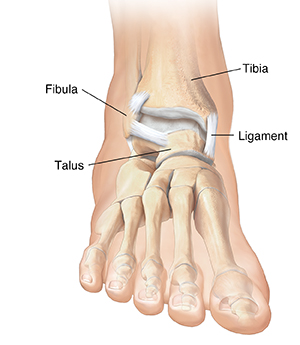Understanding an Ankle Fracture
The ankle is formed by bones in the lower leg (tibia and fibula) and the bone on top of the foot (talus). When you have a fracture of the ankle, it means that 1 or more of the bones in the ankle are broken. The bone may be cracked, broken into 2 or more pieces, or even shattered. The pieces of bone may be lined up or they may have moved out of place. Sometimes, the bone may break through the skin. Nearby ligaments may also be damaged. Depending on how badly the bone is broken, healing may take a few months or longer.

What causes an ankle fracture?
Ankle fractures are often caused from severely twisting or rolling the ankle. They may also be caused from a fall, blow, accident, or sports injury.
Symptoms of an ankle fracture
Symptoms can include immediate and severe pain, swelling, and bruising. If the bone breaks through the skin, bleeding at the site can also occur. The ankle may look crooked, deformed, or bent. Also, it may be hard to move or use the ankle and foot as you would normally. You can't put weight on it.
Treating an ankle fracture
Treatment for an ankle fracture depends on where the bone is broken and how serious the break is. If needed, the bone is put back into place. This may be done with or without surgery. If surgery is needed, the surgeon may use devices, such as pins, plates, or screws to hold the bone together. Usually, you will wear a splint, brace, boot, or short leg cast to keep the bone in place and protect it from injury during healing. Other treatments may also be used to help reduce symptoms or regain function. These include:
-
Rest. You may need to not walk or put any weight on the broken ankle for a period of time. Severe fractures need a longer limit on weight-bearing activities.
-
Cold packs. Putting an ice pack over the injured area may help reduce swelling and pain. To make an ice pack, put ice cubes in a plastic bag that seals at the top. Wrap the bag in a clean, thin towel or cloth. Don't put ice or an ice pack directly on the skin.
-
Compression. An elastic bandage may be wrapped around the ankle to help reduce swelling.
-
Elevation. Propping up the ankle so that it is above your heart may ease swelling.
-
Pain medicines. Prescription or over-the-counter pain medicines may help reduce pain and swelling. If needed, stronger pain medicines may be prescribed.
-
Exercises. Your healthcare provider may give you certain exercises to do at home or with a physical therapist. These help restore strength, flexibility, and range of motion in the ankle and foot.
Possible complications of an ankle fracture
These can include:
-
The bone doesn't heal well
-
Weakness, stiffness, or loss of range of motion in the ankle
-
Osteoarthritis in the ankle
When to call your healthcare provider
Call your healthcare provider right away if any of these occur:
-
Fever of 100.4°F (38°C) or higher, or as advised by your provider
-
Chills
-
Symptoms that don’t get better with treatment, or that get worse
-
Numbness, tingling, or coldness in your foot or toes
-
Toenails that turn blue or grey in color
-
A splint, brace, boot, or cast that is damaged or feels too tight or loose
-
Abnormal redness, warmth, swelling, bleeding, or drainage from any wounds or incision sites
-
New symptoms
Online Medical Reviewer:
Raymond Turley Jr PA-C
Online Medical Reviewer:
Stacey Wojcik MBA BSN RN
Online Medical Reviewer:
Thomas N Joseph MD
Date Last Reviewed:
7/1/2022
© 2000-2025 The StayWell Company, LLC. All rights reserved. This information is not intended as a substitute for professional medical care. Always follow your healthcare professional's instructions.